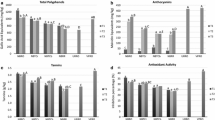Abstract
Different red wines were elaborated to study the effect of the date of the grape harvest on the levels of individual low molecular weight phenolic compounds, which are chiefly responsible for the wine color. Two red grape varieties and two consecutive years were studied at three different harvesting stages of grapes, and the changes during the 18 months of wine aging (12 months in oak barrels and 6 months in the bottle) were also followed. The results showed that the wines made from grapes harvested 1 week later than the usual date generally had higher contents of some simple phenols, which can act as cofactors that can maintain the color intensity and violet tonalities in aged wines. Besides, these wines had lower levels of caftaric and coutaric acids, which are two of the main substrates for oxidation and browning processes.





Similar content being viewed by others
References
Junquera B, Robredo LM, Díez C (1988) An Edafol Agrobiol 47:1619–1634
González-Sanjosé ML, Barrón LJR, Junquera B, Robredo LM (1991) J Food Compos Anal 4:245–255
Robredo LM, Junquera B, González-Sanjosé ML, Barrón LJ (1991) Ital J Food Sci 3:173–180
Andrades MS, González-Sanjosé ML (1995) Zubía Monográfico 7:79–102
Troost G (1985) Tecnología del vino, Ed. Omega S.A. Barcelona Spain
Salinas R, Zalacain A, Pardo F, Alonso G (2004) J Agric Food Chem 52:4821–4827
Pérez-Magariño S, González-Sanjosé ML (2004) J Agric Food Chem 52:1181–1189
Haslam E (1980) Phytochemistry 19:2577–2582
Thorngate JH (1997) Am J Enol Vitic 48:271–279
González-Sanjosé ML, Díez C (1992) Agrochimica XXXVI:63–70
González-Sanjosé ML, Barrón LJR, Díez C (1990) J Sci Food Agric 51:337–343
Fernández-de-Simón B, Estrella I, Hernández T (1993) Food Chem 47:47–52
Mazza G, Fukumoto L, Delaquis P, Girard B, Ewert B (1999) J Agric Food Chem 47:4009–4017
Kennedy JA, Hayasaka Y, Vidal S, Waters EJ, Jones GP (2001) J Agric Food Chem 49:5348–5355
Brouillard R, Mazza G, Saad Z, Albrecht AM, Cheminat A (1989) J Am Chem Soc 111:2604–2610
Brouillard R, Dangles O (1994) Food Chem 51:365–371
Peynaud E (1989) Enología Práctica, Ed. Mundi-Prensa Madrid Spain
Boulton R (2001) Am J Enol Vitic 52:67–87
Liao H, Cai Y, Haslam E (1992) J Sci Food Agric 59:299–305
Baranac JM, Petranoviv NA, Dimitric JM (1996) J Agric Food Chem 44:1333–1336
DiStefano R, Cravero MC (1990) L’Enotecnico 26:99–106
Pérez-Magariño S, González-Sanjosé ML (2002) Eur Food Res Technol 214:444–448
Pérez-Magariño S, Revilla I, González-Sanjosé ML, Beltrán S (1999) J Chromatogr A 847:75–81
CIE (1986) Colorimetry, 2nd edn. Commission Internationale de L’Eclairage, Vienna
OIV (1994) Compte Rendu des Travaux, 34 session OIV, 21–24 March 1994, Paris. Off J Eur Commun 3-X-90, 167
Darías-Martín J, Carrillo M, Díaz E, Boulton R (2001) Food Chem 73:217–220
Boursiquot JM, Sapis JC, Macheix JJ Bull Liaison Groupe Polyphénols 13:431–433
Izcara E (2004) PhD Thesis. Faculty of Sciences, University of Burgos, Spain
Fernández-de-Simón MB, Hernández T, Estrella I, Gómez-Cordovés C (1992) Z Lebensm Unters Forsch 194:351–354
Jordao AM, Ricardo-da-Silva JM, Laureano O (2001) Am J Enol Vitic 52:230–234
Pérez-Magariño S, González-Sanjosé ML (2003) Food Chem 81:301–306
Singleton VL (1987) Am J Enol Vitic 38:69–77
Glories Y (1984) Connais Vigne vin 18:253–271
Pérez-Magariño S, Izcara E, González-Sanjosé ML, González C (2001) In: XXII Jornadas de Viticultura y Enología Tierra de Barros, Ed. Cultural Santa Ana Spain, pp 449–463
Acknowledgements
The authors wish to thank the Comisión Interministerial de Ciencia y Tecnología for funding provided for this study under project FEDER 1FD-1319. The authors are also grateful to Tomás Postigo from the “Pago de Carraovejas” winery for providing the wines for this study.
Author information
Authors and Affiliations
Corresponding author
Rights and permissions
About this article
Cite this article
Pérez-Magariño, S., González-San José, M.L. Effect of ripening stage of grapes on the low molecular weight phenolic compounds of red wines. Eur Food Res Technol 220, 597–606 (2005). https://doi.org/10.1007/s00217-004-1106-z
Received:
Published:
Issue Date:
DOI: https://doi.org/10.1007/s00217-004-1106-z




